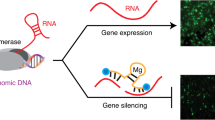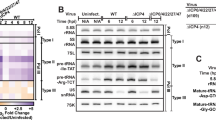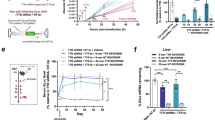Abstract
Thymidylate synthase (TS) is an essential enzyme that synthesizes thymidylic acid in the de novo biosynthetic pathway. Inhibiting TS enzyme activity with substrate or cofactor analogs leads to inhibition of DNA replication and cell death. For this reason, TS is an important target enzyme for cancer chemotherapeutic drugs. We describe an alternative approach to reducing cellular TS enzyme activity using short interfering RNA (siRNA) technology to lower TS mRNA levels. Plasmids that direct the synthesis of siRNAs that target nucleotides 898–916 and 965–983 (relative to the A of the translational start codon) of human TS mRNA were highly effective at reducing TS enzyme levels in transient transfection assays. Infection of HeLa cells with retroviruses that contain the effective siRNA genes led to a stable 80–95% reduction of TS enzyme and mRNA. A similar percent reduction in TS expression was observed in a cell line that overproduces TS enzyme 100-fold due to TS gene amplification. Cells that exhibited the greatest reduction in TS enzyme level grew poorly in medium that lacked thymidine. These observations suggest that siRNA approaches may provide an alternative therapeutic strategy to reduce TS enzyme levels.
This is a preview of subscription content, access via your institution
Access options
Subscribe to this journal
Receive 12 print issues and online access
$259.00 per year
only $21.58 per issue
Buy this article
- Purchase on Springer Link
- Instant access to full article PDF
Prices may be subject to local taxes which are calculated during checkout





Similar content being viewed by others
References
Carreras CW, Santi DV . The catalytic mechanism and structure of thymidylate synthase. Annu Rev Biochem 1995; 64: 721–762.
Danenberg PV . Thymidylate synthetase – a target enzyme in cancer chemotherapy. Biochim Biophys Acta 1977; 473: 73–92.
Jackman AL, Boyle FT, Harrap KR . Tomudex(TM) (ZD1694): from concept to care, a programme in rational drug discovery. Invest New Drugs 1996; 14: 305–316.
Danenberg PV, Malli H, Swenson S . Thymidylate synthase inhibitors. Semin Oncol 1999; 26(6): 621–631.
Barbour KW, Hoganson DK, Berger SH, Berger FG . A naturally occurring tyrosine to histidine replacement at residue 33 of human thymidylate synthase confers resistance to 5-fluoro-2′-deoxyuridine in mammalian and bacterial cells. Mol Pharmacol 1992; 42(2): 242–248.
Washtien WL . Increased levels of thymidylate synthetase in cells exposed to 5-fluorouracil. Mol Pharmacol 1984; 25: 171–177.
Welsh SJ, Titley J, Brunton L, Valenti M, Monaghan P, Jackman AL et al. Comparison of thymidylate synthase (TS) protein up-regulation after exposure to TS inhibitors in normal and tumor cell lines and tissues. Clin Cancer Res 2000; 6(6): 2538–2546.
Peters GJ, Backus HH, Freemantle S, van Triest B, Codacci-Pisanelli G, van der Wilt CL et al. Induction of thymidylate synthase as a 5-fluorouracil resistance mechanism. Biochim Biophys Acta 2002; 1587(2–3): 194–205.
Kitchens ME, Forsthoefel AM, Rafique Z, Spencer HT, Berger FG . Ligand-mediated induction of thymidylate synthase occurs by enzyme stabilization – Implications for autoregulation of translation. J Biol Chem 1999; 274: 12544–12547.
Chu E, Koeller DM, Casey JL, Drake JC, Chabner BA, Elwood PC et al. Autoregulation of human thymidylate synthase messenger RNA translation by thymidylate synthase. Proc Natl Acad Sci USA 1991; 88: 8977–8981.
Chu E, Allegra CJ . The role of thymidylate synthase as an RNA binding protein. BioEssays 1996; 18: 191–198.
Liu J, Schmitz JC, Lin X, Tai N, Yan W, Farrell M et al. Thymidylate synthase as a translational regulator of cellular gene expression. Biochim Biophys Acta 2002; 1587(2–3): 174–182.
Rossana C, Rao LG, Johnson LF . Thymidylate synthetase overproduction in 5-fluorodeoxyuridine-resistant mouse fibroblasts. Mol Cell Biol 1982; 2: 1118–1125.
Jenh C-H, Geyer PK, Baskin F, Johnson LF . Thymidylate synthase gene amplification in fluorodeoxyuridine-resistant mouse cell lines. Mol Pharmacol 1985; 28: 80–85.
Berger SH, Jenh C-H, Johnson LF, Berger FG . Thymidylate synthase overproduction and gene amplification in fluorodeoxyuridine-resistant human cells. Mol Pharmacol 1985; 28: 461–467.
Hannon GJ . RNA interference. Nature 2002; 418(6894): 244–251.
Dykxhoorn DM, Novina CD, Sharp PA . Killing the messenger: short RNAs that silence gene expression. Nat Rev Mol Cell Biol 2003; 4(6): 457–467.
Brummelkamp TR, Bernards R, Agami R . Stable suppression of tumorigenicity by virus-mediated RNA interference. Cancer Cell 2002; 2(3): 243–247.
McCaffrey AP, Meuse L, Pham TT, Conklin DS, Hannon GJ, Kay MA . RNA interference in adult mice. Nature 2002; 418(6893): 38–39.
Gitlin L, Karelsky S, Andino R . Short interfering RNA confers intracellular antiviral immunity in human cells. Nature 2002; 418(6896): 430–434.
Jacque JM, Triques K, Stevenson M . Modulation of HIV-1 replication by RNA interference. Nature 2002; 418(6896): 435–438.
Nussbaum RL, Walmsley RM, Lesko JG, Airhart SD, Ledbetter DH . Thymidylate synthase-deficient Chinese hamster cells: a selection system for human chromosome 18 and experimental system for the study of thymidylate synthase regulation and fragile X expression. Am J Hum Genet 1985; 37: 1192–1205.
Nolan GP, Shatzman AR . Expression vectors and delivery systems. Curr Opin Biotechnol 1998; 9(5): 447–450.
Paddison PJ, Caudy AA, Bernstein E, Hannon GJ, Conklin DS . Short hairpin RNAs (shRNAs) induce sequence-specific silencing in mammalian cells. Genes Dev 2002; 16(8): 948–958.
Lockshin A, Moran RG, Danenberg PV . Thymidylate synthetase purified to homogeneity from human leukemic cells. Proc Natl Acad Sci USA 1979; 76: 750–754.
Liu W, Saint DA . A new quantitative method of real-time reverse transcription polymerase chain reaction assay based on simulation of polymerase chain reaction kinetics. Anal Biochem 2002; 302(1): 52–59.
Bustin SA . Absolute quantification of mRNA using real-time reverse transcription polymerase chain reaction assays. J Mol Endocrinol 2000; 25(2): 169–193.
Keyomarsi K, Moran RG . Mechanism of the cytotoxic synergism of fluoropyrimidines and folinic acid in mouse leukemic cells. J Biol Chem 1988; 263(28): 14402–14409.
Schmitz JC, Chen TM, Chu E . Small interfering double-stranded RNAs as therapeutic molecules to restore chemosensitivity to thymidylate synthase inhibitor compounds. Cancer Res 2004; 64(4): 1431–1435.
Koehler SE, Ladner RD . Small interfering RNA-mediated suppression of dUTPase sensitizes cancer cell lines to thymidylate synthase inhibition. Mol Pharmacol 2004; 66(3): 620–626.
Rahman L, Voeller D, Rahman M, Lipkowitz S, Allegra C, Barrett JC et al. Thymidylate synthase as an oncogene: a novel role for an essential DNA synthesis enzyme. Cancer Cell 2004; 5(4): 341–351.
Bertino JR, Banerjee D . Thymidylate synthase as an oncogene? Cancer Cell 2004; 5(4): 301–302.
Acknowledgements
We thank Drs Gustavo Leone and Dan Schoenberg for helpful discussions and reagents. These studies were supported by a grant from the National Institute for General Medical Sciences (GM29356) to LFJ and a Comprehensive Cancer Center Core grant from the National Cancer Institute (CA16058).
Author information
Authors and Affiliations
Corresponding author
Rights and permissions
About this article
Cite this article
Yang, Z., Cloud, A., Hughes, D. et al. Stable inhibition of human thymidylate synthase expression following retroviral introduction of an siRNA gene. Cancer Gene Ther 13, 107–114 (2006). https://doi.org/10.1038/sj.cgt.7700880
Received:
Revised:
Accepted:
Published:
Issue Date:
DOI: https://doi.org/10.1038/sj.cgt.7700880
Keywords
This article is cited by
-
Lentivector-mediated RNAi efficiently downregulates expression of murine cdk4 gene in vitro
Frontiers of Medicine in China (2009)



